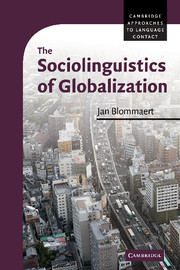Book contents
- Frontmatter
- Contents
- List of illustrations
- Series editor's foreword
- Preface
- Acknowledgements
- 1 A critical sociolinguistics of globalization
- 2 A messy new marketplace
- 3 Locality, the periphery and images of the world
- 4 Repertoires and competence
- 5 Language, globalization and history
- 6 Old and new inequalities
- 7 Reflections
- Notes
- References
- Index
2 - A messy new marketplace
Published online by Cambridge University Press: 05 June 2012
- Frontmatter
- Contents
- List of illustrations
- Series editor's foreword
- Preface
- Acknowledgements
- 1 A critical sociolinguistics of globalization
- 2 A messy new marketplace
- 3 Locality, the periphery and images of the world
- 4 Repertoires and competence
- 5 Language, globalization and history
- 6 Old and new inequalities
- 7 Reflections
- Notes
- References
- Index
Summary
Sociolinguistics is the study of language as a complex of resources, of their value, distribution, rights of ownership and effects. It is not the study of an abstract language, but the study of concrete language resources in which people make different investments and to which they attribute different values and degrees of usefulness. In the context of globalization, where language forms are perhaps more mobile than before, such patterns of value and use become less predictable and presupposable. Economic metaphors such as those developed by Bourdieu (1991) are particularly useful for a sociolinguistics of globalization. Recall that Bourdieu saw language as a market of symbolic capital and power, with people juggling for profit and with some people structurally having less capital than others. Bourdieu and his contemporaries Bernstein (1971) and Hymes (1980, 1996) all drew our attention to the same phenomenon: that the world of language is not just one of difference but one of inequality; that some of that inequality is temporal and contingent on situations while another part of it is structural and enduring; and that such patterns of inequality affect, and articulate around, actual, concrete, language forms such as accents, dialects, registers and particular stylistic (e.g. narrative) skills.
The symbolic marketplace described by Bourdieu and others was a local and relatively closed one. Its patterns of value attribution and the logic of the economic game were clear to most of the people involved in the transactions – the speaker from la province knew quite well that their speech was ‘inferior’ to that of the Parisian, and this awareness accounted for their tendency towards hypercorrection.
- Type
- Chapter
- Information
- The Sociolinguistics of Globalization , pp. 28 - 62Publisher: Cambridge University PressPrint publication year: 2010

